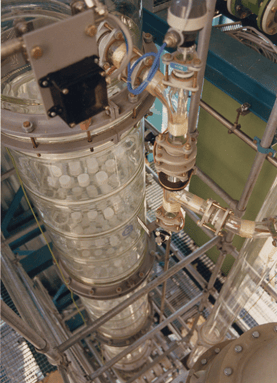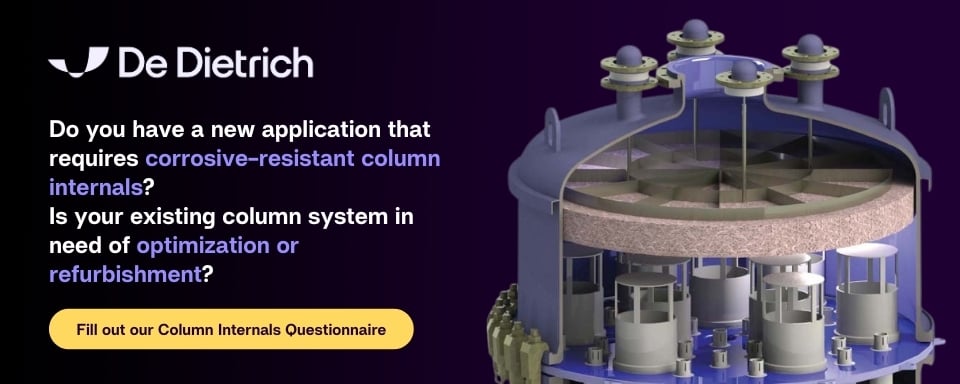Frequently Asked Questions about Columns and Column Internals
 Like a lot of other types of process equipment, columns are a complex apparatus that involve many parts working together as a system. It may look like just a big, long pipe from the outside, but there is an intricate network of components inside, each tasked with a specific job to do (for more information on this read An Introductory Guide to Columns and their Internal Components blog post).
Like a lot of other types of process equipment, columns are a complex apparatus that involve many parts working together as a system. It may look like just a big, long pipe from the outside, but there is an intricate network of components inside, each tasked with a specific job to do (for more information on this read An Introductory Guide to Columns and their Internal Components blog post).
Even if you are familiar with the schematics of a column, there are still questions you will probably have when it comes time to scope out a system for your process. We’ve compiled a list of frequently asked questions to help answer some of the most common questions we receive from customers.
Q: Can De Dietrich Process Systems install internals in columns that were manufactured by another company?
A: Yes! If you have an existing PTFE-lined, glass-lined, or glass column that was made by another manufacturer, we can still install our column internals. A shop drawing of the existing column is required to make sure there are no constructive interferences with the internals. We can also provide the internals based on the engineering design done by the customer.
If you have a confidentiality concerns with providing drawings from other manufacturers, you can be assured that we are only interested in the information relevant to the internals. We can sign a confidentiality agreement upon request.
Q: What is the maximum size of the DUPA/DURAPACK packing to be applied?
A: When installing DUPA we allow a maximum packing height of 16.4 ft. In most cases, this height is sufficient. For larger packing heights it is necessary to include collection and redistribution of the fluids inside the column.
Q: What are the theoretical stages of structured DUPA packing?
A: For aqueous media the stages are about 2.2 to 2.6 m/m with organics media at about 3.8 to 4.2 m/m depending on the viscosity of the media and column load.
Q: What is the maximum operating temperature for the DDPS internals?
A: This depends on the type of internal and the installed materials. As a rule, we are aiming for a maximum operating temperature of 400° F for all our installations. Many of our internals are also approved to 450° F.
Q: What guarantee does DDPS provide for design / layout of a column?
A: Our warranty depends greatly on the scope of supply. In principle, we can give both a hydrodynamic as well as a process guarantee. For a hydrodynamic guarantee, the customer has a specific request for number of theoretical plates, density of liquid load, pressure drop, etc. which will be guaranteed with the delivery of our internals. When a process guarantee is requested, the purity of the overhead and bottom streams plus the required number of separation stages are part of DDPS’ design and have to meet the customer’s requirements.
Q: How sensitive are DDPS internals against solids in the feed?
A: Columns are built to handle liquid-gas media. Solids, depending on the size of the grain, their stick effect, and the concentration in the liquid are considered more challenging and are therefore treated as a separate entity. Not all internals tolerate solids, although a few internals in particular (e.g. Core-tray distributors) have a higher “solids loading” suitability. Our glass packing DURAPACK is very anti-adhesive, due to its fire-polished surface and cleanability. Please contact us for your specific application and the anticipated solids, we will find a custom solution for your application.
Q: How sensitive are DDPS internals against outgassing/flushing within the feed?
A: This depends on the type of distributor used and the position of the feed inlet pipe. Glass channel distributors are susceptible to outgassing or flash media versus Core-trays which are very insensitive. An upstream distribution box, also known as a “flash box”, should provide an effective solution.
Q: Can the glass packing scratch the glass lining inside the column?
A: No. In the areas where the glass packing is mounted, the glass-lined surface is harder than our glass, due to pre-stress of glass lining on steel. Structured packing, such as DURAPACK, is always mounted with a certain distance from the glass-lined wall to ensure the proper functioning of sealing. Also, in the case of glass Raschig rings, no mechanical damage to the glass-lining layer should occur.
Q: What kind of documentation will I receive?
A: This depends on your scope of supply. If you only need to purchase internals, you will receive datasheets, and once committed, test reports for the liquid distributor trial. If you are in the market for a full package, i.e. a column shell with internals, we will create a 3D-assembly drawing. In each case we will supply operation and maintenance manuals. Other documentation components can be arranged individually.
Q: Can DDPS also use parts from my old system?
A: Sometimes. Due to changes in technology though, many used internals are no longer up to date. Furthermore, they are often too corroded and don’t warrant being used alongside new equipment. If you have components that you think are in good condition to reuse, you can speak with a DDPS representative and they can help determine if they are suitable
Q: What are the advantages of DDPS packing and internals versus glass-filled Tefzel tri-packs packing, distributors, and supports?
A: This is a short question, but the answer could be long if we were to do an in-depth product comparison, because there are so many things the material is influenced by - operating conditions (temperature, medium, liquid load factor, possible scale, F-factor) and applicable dimensions (diameter of column, size of packing, total packing height). To sum it up, glass internals are better with respect to universal corrosion resistance, high-temperature at all diameters/dimensions, smaller liquid loads, and required packing height. The specifications of your process will help to further identify what material is better for you.
If you’re still in the preliminary stages and want to do more research into columns, our brochure on Process Solutions for Mass and Thermal Separation will give you an overview of the internals used in columns that handle aggressive media. If you want to speak with someone in more detail, fill out our Column Internals Questionnaire so we can find out more about your process.
